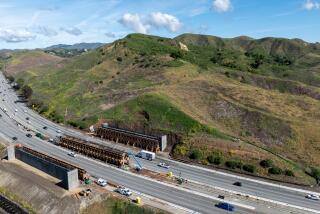New Developer Dusts Off Plan for Extending Orange Freeway
A Phoenix toll-road developer has acquired the rights to build the long-stalled extension of the Orange Freeway, renewing concerns by local officials that an elevated road above the Santa Ana River would damage their communities.
Interwest Cos. recently picked up the rights to build the toll-road extension from Greiner Inc., an engineering firm with its Southern California office in Santa Ana. Greiner will remain as project engineer.
But cities adjacent to the Santa Ana River want to kill the proposal.
“The city of Fountain Valley is fairly well against this project,” Fountain Valley Mayor John Collins said.
He said the sight of an elevated freeway, even with sound walls, was enough to diminish the quality of life for residents. Collins also is concerned about an increase in surface street traffic from toll-road entrances and exits.
Santa Ana City Manager David N. Ream said he told Interwest officials that opposition would make it “extremely difficult if not impossible to build the project they had in mind.”
River Glen, a new housing development under construction, overlooks the riverbed, he said, and “people buying those golf-course-view homes are certainly not going to support a freeway by their door.”
Preliminary plans for the 11-mile toll road would extend the Orange Freeway from the Orange Crush--the notoriously jammed convergence of the Santa Ana, Orange and Garden Grove freeways--to the San Diego Freeway in Fountain Valley. The toll road would rise 25 to 30 feet above the Santa Ana River bed, with sound walls on either side.
Interwest, which has built other toll roads, will decide by this fall if the project is feasible, said its president, Robert E. Farris. He figures that the project, which would cost $500 million to $600 million, has “maybe a little better” than a 50-50 chance of getting built.
“We have to have a forecast of sufficient use of the road to finance the project,” said Farris, who was federal highway administrator under President Ronald Reagan.
Interwest has until 2001, which was Greiner’s deadline, to complete a proposal and have financing lined up.
The Phoenix company’s interest in reviving the moribund project is the second attempt this year to get it back on track.
In January, Assemblyman Scott Baugh (R-Huntington Beach) launched an effort to create a consortium of cities and public agencies to start building the project before 2001. Baugh has put his legislation creating the consortium on hold until Interwest decides whether to proceed.
A number of setbacks, including a recession that dried up financing opportunities, have bedeviled the project since 1989 when the state granted Greiner rights to build the toll road. Greiner wasn’t able to raise the necessary funds and eventually went into a partnership on the project with Interwest.
The deal is part of an experiment to use private funds to help develop California’s highway network. Orange County already has 61 miles of toll roads, the most in the state.
“Right now seems to be the best time for that road ever,” said Steve Pearson, senior vice president of Greiner, which recently merged and changed its name to URS Greiner Woodward Clyde.
Pearson said other projects designed to alleviate congestion haven’t helped enough. That includes the widening of the Orange Crush intersection of the three freeways.
If the extension of the Orange Freeway is built, Farris said, it would be financed by tax-exempt bonds. He said his firm, which is building a toll road in South Carolina, specializes in public-private partnerships. Farris said Orange County officials have given him assurances of support.
Orange County Supervisor Todd Spitzer qualified his support.
“It has potential to be an exciting project for the region, but it is obviously not without significant political barriers,” Spitzer said.
More to Read
Sign up for Essential California
The most important California stories and recommendations in your inbox every morning.
You may occasionally receive promotional content from the Los Angeles Times.










